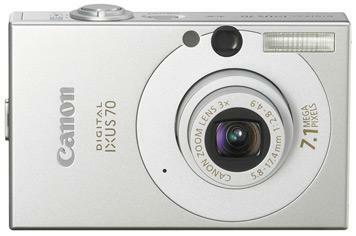Gadget flashback – Canon IXUS
Although better known for its pro-level kit, Canon hasn’t shirked its approach to consumer cams and has produced some of the finest point-and-shooters

Although better known for its pro-level kit, Canon hasn’t shirked its approach to consumer cams and has produced some of the finest point-and-shooters we’ve ever seen. And it wasn’t just the know-how of lens boffs that made the IXUS range what it is today – Canon’s compacts often displayed a knack for design flair, no mean feat when you consider their consistently recognisable faces.
The APS 24mm film format’s fate had not yet been written when the first IXUS rocked up. It was to set a design template that Canon has carried through to this day, and the action on that pop-up flash was wondrous. The IXUS was no slouch in action either – it was the smallest autofocus zoom cam you could procure in ’96, and it had all those quirky APS tricks on its side. Okay, APS was rubbish, but the IXUS was godly to behold.
The digital incarnation of the IXUS marked a coming of age for Canon’s compact range. It carried across the 2x zoom lens from the APS cams, adding three-point autofocus to help amateur photographers capture top results to the 2.1MP CCD sensor. Ready to feel old? At the time of launch, Canon boasted about the shooting interval – an interminable wait of 1.7 seconds. On the plus side, you could shoot 46 images on the bundled 8MB CF card if you set it to lowest quality. Hmm.
Although it didn’t change much at base level, the IXUS v did add intelligent auto-exposure and white balance, plus a primary colour filter. Not exactly Earth-shattering stuff, but it was the first IXUS to have video capabilities and could capture audio at the same time – a taste of things to come. Its other brag was reduced power consumption, allowing snappers to shoot around 120 pics without plugging in for a recharge, even when using the LCD screen.
By this stage of the game, Canon’s compacts had moved to nine-point autofocus, 3.2MP sensors and ultrathin LCD monitors (although still hobbled by the miserable 1.5in viewing area typical of the time). The IXUS II was notable for being faster – it could shoot 2.2 images per second – and for introducing a new storage method, the SD card. Billed braggishly as ‘postage stamp sized’, it was a new era for camera storage. But would it catch on?
Whoa! Count ’em – 7MP. These were the beginnings of the megapixel war that would rage – without any real justification – through compact camera land for the foreseeable future. The 700 tweaked the boxy design, added a 2in LCD and refined the controls. But it had better sense than to rely on a new wardrobe. Behind the scenes, Canon’s latest had pilfered the EOS-1D Mark II’s DIGIC II image engine. It also introduced basic on-board picture editing.
Although, earlier in the year Canon had outed the IXUS 70, a return to no-nonsense box design, the 960 IS ushered in a more progressive look. It had lots to shout about, from its 12.1MP sensor to its 3.7x zoom and image stabilisation, but we wanted it only for its body. That’s because the 960 was crafted from titanium, meaning it could survive being dropped into the Grand Canyon, despite tipping the scales to just 165g. Read the review here.
Proof that not even a serious camera brand could resist the lure of ‘funky’ colours, the IXUS 95 appeared in a series of jaunty hues. Checking in at a sensible 10MP, it ticks all the boxes required of a point-and-shoot, like face recognition and a 4x zoom, but was otherwise unremarkable. There were more impressively specced cameras emerging from Canon’s labs, but none were quite as much fun.
Inevitably, in 2009, the IXUS range would get touchscreen controls, and that inevitability manifested itself in the 200 IS. Despite some stagnation in the design, the 12MP compact also has the characteristically robust build of an IXUS and decent results can be viewed on the 3in screen. Touch focus and swipe controls are present and correct, while the camera takes on most of the burden of setting up shot on its own. You can read our review here.
Nine years after first introducing video to a camera, the 10MP IXUS 300 HS is hoping to take it to new levels with super-slo-mo shooting at 240fps. Naturally, burst shooting is also impressive at 3.7 shots per second at full res, or 8.4 shots at 2.5MP – a slight improvement over the half a shot per second continuous rate of the original Digital IXUS. That’s arriving at the end of May 2010.
More Gadget flashbacks on Stuff.tv
IXUS reviews on Stuff.tv
– IXUS 75


